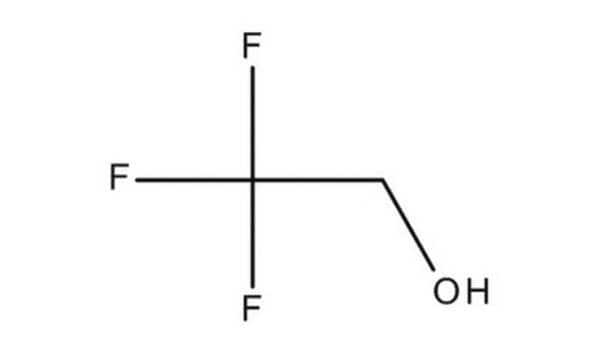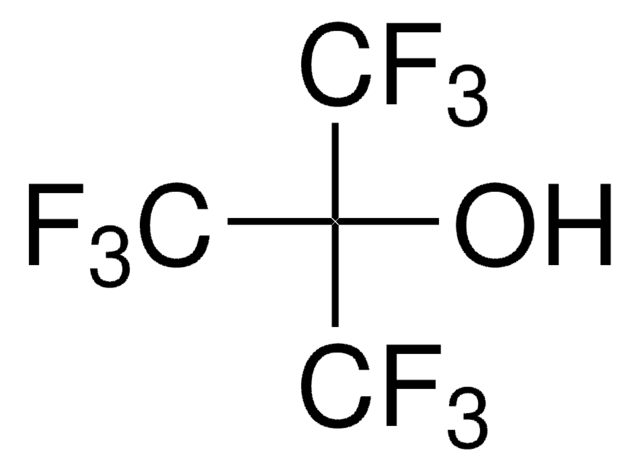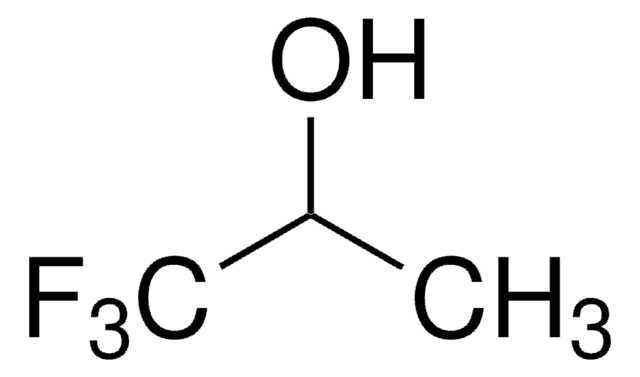T63002
2,2,2-Trifluoroethanol
ReagentPlus®, ≥99%
Sinônimo(s):
Trifluoroethyl alcohol
About This Item
Produtos recomendados
densidade de vapor
3.5 (vs air)
Nível de qualidade
pressão de vapor
70 mmHg ( 25 °C)
linha de produto
ReagentPlus®
Ensaio
≥99%
forma
liquid
temperatura de autoignição
~896 °F
Lim. expl.
42 %
índice de refração
n20/D 1.3 (lit.)
pH
7
pb
77-80 °C (lit.)
pf
−44 °C (lit.)
densidade
1.373 g/mL at 25 °C (lit.)
cadeia de caracteres SMILES
OCC(F)(F)F
InChI
1S/C2H3F3O/c3-2(4,5)1-6/h6H,1H2
chave InChI
RHQDFWAXVIIEBN-UHFFFAOYSA-N
Procurando produtos similares? Visita Guia de comparação de produtos
Descrição geral
Aplicação
- In the synthesis of 2-amino-3-cyano-4H-chromene and tetrahydrobenzo[b]pyran derivatives by catalyst free one-pot condensation of aldehydes, malononitrile and resorcinol or dimedone.
- In the N-formylation of amines with formic acid in the presence of heterogeneous ZIF-8 (zeolitic imidazolate framework) catalyst.
- In the preparation of 2-substituted-2,3-dihydro-4(1H)-quinazolinone derivatives by condensation of anthranilamide with alkyl, aryl, or heteroaryl ketones or aldehydes.
- In the mild and selective oxidation of sulfur compounds using H2O2(hydrogen peroxide).
Características e benefícios
Informações legais
Palavra indicadora
Danger
Frases de perigo
Declarações de precaução
Classificações de perigo
Acute Tox. 3 Inhalation - Acute Tox. 3 Oral - Eye Dam. 1 - Flam. Liq. 3 - Repr. 1B - STOT RE 2 Inhalation
Órgãos-alvo
Blood
Código de classe de armazenamento
3 - Flammable liquids
Classe de risco de água (WGK)
WGK 1
Ponto de fulgor (°F)
86.0 °F - closed cup
Ponto de fulgor (°C)
30 °C - closed cup
Certificados de análise (COA)
Busque Certificados de análise (COA) digitando o Número do Lote do produto. Os números de lote e remessa podem ser encontrados no rótulo de um produto após a palavra “Lot” ou “Batch”.
Já possui este produto?
Encontre a documentação dos produtos que você adquiriu recentemente na biblioteca de documentos.
Os clientes também visualizaram
Nossa equipe de cientistas tem experiência em todas as áreas de pesquisa, incluindo Life Sciences, ciência de materiais, síntese química, cromatografia, química analítica e muitas outras.
Entre em contato com a assistência técnica













